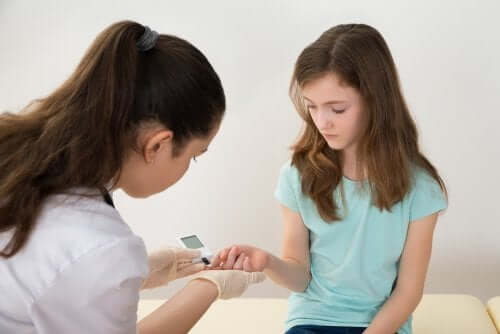Type 1 Diabetes in Children: What You Should Know

Type 1 diabetes in children usually represents an overwhelming diagnosis for some mothers. Many fall prey to nerves due to the new care their child begins to require. For example, learning how to inject, controlling their child’s blood sugar levels, and counting the carbohydrates they consume.
Some parents even think their child won’t grow properly nor have a good childhood. In addition, they may believe they’ll be rejected by their groups of friends or will isolate themselves from others because they feel different.
This isn’t true at all. Type 1 diabetes in children is a disease that, like any other, requires recurring care and attention. Thanks to medical advances and achievements, any child that suffers from it can lead a normal life if they regularly monitor their blood sugar and administer the corresponding daily insulin dose.
What’s type 1 diabetes?
Type 1 diabetes occurs when the pancreas doesn’t produce insulin. The body needs this substance to allow glucose to pass from the blood into cells, where the body uses it for energy or stores it for later use. Without it, sugar can’t do its job. In other words, it stays in the blood and, consequently, blood sugar levels rise.
Symptoms of type 1 diabetes in children
Type 1 diabetes can develop gradually or abruptly. A person can have it without even knowing it because, in most cases, the symptoms aren’t that obvious. Children and adolescents may manifest the following signs:
- Excessive urination. This is nothing but the kidneys’ response to high blood glucose concentrations, as they try to eliminate it through urine.
- Drinking plenty of fluids. As they lose fluids due to constant urination, children may feel very thirsty and drink plenty of water to keep it in their bodies.

- Excessive weight loss. Children with type 1 diabetes tend to have more appetite than usual. When they eat, their body breaks down muscle and accumulated fat in their attempt to provide energy to the cells that need glucose and don’t have access to it. Often, they feel tired and lack energy.
- In some cases, children can wet the bed at night, even if this never happened before. Also, girls who haven’t reached puberty yet may develop vaginal candidiasis (yeast infection).
Diagnosis
To know for sure if a child has diabetes, it’s necessary to measure blood glucose levels. If the values are higher than normal, the medical professional should perform other tests to identify whether the child suffers from type 1 or 2 diabetes.
Then, the doctor will refer the child to a pediatric endocrinologist, the specialist responsible for diseases such as diabetes and growth problems. This specialist will indicate the necessary treatment to keep the disease under control.
Type 1 diabetes can’t be prevented and there’s no way to predict who will develop it. Thus, it isn’t hereditary because genes aren’t enough to trigger the disease. Once a child contracts it, it never goes away and requires lifelong treatment.
Treatment of type 1 diabetes in children
The child will need medical treatment under the supervision of a pediatric endocrinologist. This specialist will be responsible for providing a list of recommendations to prevent possible health problems and help the child develop normally at a physical, social, and emotional level. For this, the child:
- Needs insulin administration according to medical recommendations.
- Has to follow a healthy and balanced diet, controlling carbohydrates at each meal.
- Requires periodic blood sugar level measurements.
- Has to do regular physical activity.
There’s no known cure for this disease. Therefore, the child will need medical treatment for the rest of their life. If they follow the treatment properly, they’ll feel strong and will be able to live a long and prosperous life.
If your child hasn’t been diagnosed with this condition and, therefore, it’s left untreated, chemicals called ketones begin to build up in the blood. In turn, this will cause stomach pain, vomiting, nausea, breathing problems and, in some cases, loss of consciousness.

This silent disease can cause long-term heart disease, strokes, impaired vision, and kidney damage. Also, it often causes blood vessel, nerve, and gum injuries. That’s why timely treatment is very important.
Conclusion
Type 1 diabetes in children is a more common pathology than what was previously assumed. The fact that there’s no known cure yet doesn’t mean that an affected child can’t lead a normal and enjoyable life.
The important thing is to follow a rigorous treatment and give the child the necessary love to boost their confidence and help them grow physically and emotionally healthy.
Type 1 diabetes in children usually represents an overwhelming diagnosis for some mothers. Many fall prey to nerves due to the new care their child begins to require. For example, learning how to inject, controlling their child’s blood sugar levels, and counting the carbohydrates they consume.
Some parents even think their child won’t grow properly nor have a good childhood. In addition, they may believe they’ll be rejected by their groups of friends or will isolate themselves from others because they feel different.
This isn’t true at all. Type 1 diabetes in children is a disease that, like any other, requires recurring care and attention. Thanks to medical advances and achievements, any child that suffers from it can lead a normal life if they regularly monitor their blood sugar and administer the corresponding daily insulin dose.
What’s type 1 diabetes?
Type 1 diabetes occurs when the pancreas doesn’t produce insulin. The body needs this substance to allow glucose to pass from the blood into cells, where the body uses it for energy or stores it for later use. Without it, sugar can’t do its job. In other words, it stays in the blood and, consequently, blood sugar levels rise.
Symptoms of type 1 diabetes in children
Type 1 diabetes can develop gradually or abruptly. A person can have it without even knowing it because, in most cases, the symptoms aren’t that obvious. Children and adolescents may manifest the following signs:
- Excessive urination. This is nothing but the kidneys’ response to high blood glucose concentrations, as they try to eliminate it through urine.
- Drinking plenty of fluids. As they lose fluids due to constant urination, children may feel very thirsty and drink plenty of water to keep it in their bodies.

- Excessive weight loss. Children with type 1 diabetes tend to have more appetite than usual. When they eat, their body breaks down muscle and accumulated fat in their attempt to provide energy to the cells that need glucose and don’t have access to it. Often, they feel tired and lack energy.
- In some cases, children can wet the bed at night, even if this never happened before. Also, girls who haven’t reached puberty yet may develop vaginal candidiasis (yeast infection).
Diagnosis
To know for sure if a child has diabetes, it’s necessary to measure blood glucose levels. If the values are higher than normal, the medical professional should perform other tests to identify whether the child suffers from type 1 or 2 diabetes.
Then, the doctor will refer the child to a pediatric endocrinologist, the specialist responsible for diseases such as diabetes and growth problems. This specialist will indicate the necessary treatment to keep the disease under control.
Type 1 diabetes can’t be prevented and there’s no way to predict who will develop it. Thus, it isn’t hereditary because genes aren’t enough to trigger the disease. Once a child contracts it, it never goes away and requires lifelong treatment.
Treatment of type 1 diabetes in children
The child will need medical treatment under the supervision of a pediatric endocrinologist. This specialist will be responsible for providing a list of recommendations to prevent possible health problems and help the child develop normally at a physical, social, and emotional level. For this, the child:
- Needs insulin administration according to medical recommendations.
- Has to follow a healthy and balanced diet, controlling carbohydrates at each meal.
- Requires periodic blood sugar level measurements.
- Has to do regular physical activity.
There’s no known cure for this disease. Therefore, the child will need medical treatment for the rest of their life. If they follow the treatment properly, they’ll feel strong and will be able to live a long and prosperous life.
If your child hasn’t been diagnosed with this condition and, therefore, it’s left untreated, chemicals called ketones begin to build up in the blood. In turn, this will cause stomach pain, vomiting, nausea, breathing problems and, in some cases, loss of consciousness.

This silent disease can cause long-term heart disease, strokes, impaired vision, and kidney damage. Also, it often causes blood vessel, nerve, and gum injuries. That’s why timely treatment is very important.
Conclusion
Type 1 diabetes in children is a more common pathology than what was previously assumed. The fact that there’s no known cure yet doesn’t mean that an affected child can’t lead a normal and enjoyable life.
The important thing is to follow a rigorous treatment and give the child the necessary love to boost their confidence and help them grow physically and emotionally healthy.
All cited sources were thoroughly reviewed by our team to ensure their quality, reliability, currency, and validity. The bibliography of this article was considered reliable and of academic or scientific accuracy.
- Shara R. Bialo. (2018) Diabetes tipo 1: ¿Qué es? [online] Kids Health. Disponible en: https://www.kidshealth.org/es/parents/type1-esp.html
This text is provided for informational purposes only and does not replace consultation with a professional. If in doubt, consult your specialist.








